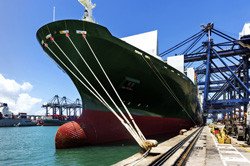Automated support for berthing vessels
Maritime trade depends on efficiency of large ships and tankers, which is sometimes accompanied by risks related to cargo transfer and berthing. The EU-funded DOCKINGMONITOR (DockingMonitor - development of automated combined berthing aid and drift monitoring system for large ships, particularly oil and LNG gas tankers) project sought to overcome berthing and cargo transfer challenges. It worked on developing a combined berthing aid and drift monitoring system which improves this processes and reduces risks. Current systems require the distribution of several sensors on the dock to achieve this. Bringing together partners from Denmark, Germany, Italy and Norway, the project proposed a portable distance measure system or ‘docking monitor’ to overcome limitations. The team envisioned a new drift monitoring system for moored vessels that exploits image processing to track a vessel’s motion during cargo transfer. It conceived a laser scanning distance measurement system to support the concept. Work began with defining the concept and specifying the requirements for a camera-based system able to measure drift. The project then collected information about and defined specifications for a docking monitor enclosure and for the proposed monitoring and control techniques. Further specifications were defined for various other subsystems. The team analysed the relevant motion measuring algorithms and selected the most suitable ones to advance its research. Related evaluations were performed on candidate concepts for providing focused and evenly illuminated images of a ship's hull regardless of ship movement. DOCKINGMONITOR subsequently established camera-hardware communication and developed image processing algorithms. After acquiring necessary lighting and optical equipment, researchers conducted performance tests with a robot system and dummy hull. Consortium members elaborated their concept for the transverse movement monitor, which included development of a custom 2D laser scanner and off-the-shelf laser pointer for testing. More realistic trials were also conducted at the Port of Oslo, Norway, using a 3D scanner. Lastly, the team gathered information affecting validation of the complete system at Nyhamna, Norway. Overall, this led to the development of a prototype that involves machine vision, laser technology, control electronics, and mechanical design. The project team also validated the system based on repeated testing, ensuring it could track velocity and motion of vessels accurately. In short, the system increases automation and offers immediate data to operators, whether through desktop computers or portable devices. In case of any impending mishaps, an alarm system can communicate with human operators both on the ship and on shore. The technology holds significant promise in upgrading port safety, minimising environmental hazards, improving birthing and reducing cargo transfer issues.







